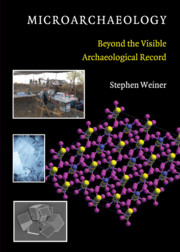Book contents
- Frontmatter
- Contents
- Preface
- 1 Archaeology, Archaeological Science, and Microarchaeology
- 2 Information Embedded in the Microscopic Record
- 3 Completeness of the Archaeological Record
- 4 Common Mineral Components of the Archaeological Record
- 5 Biological Materials: Bones and Teeth
- 6 Biological Materials: Phytoliths, Diatoms, Eggshells, Otoliths, and Mollusk Shells
- 7 Reconstructing Pyrotechnological Processes
- 8 Biological Molecules and Macromolecules: Protected Niches
- 9 Ethnoarchaeology of the Microscopic Record: Learning from the Present
- 10 Absolute Dating: Assessing the Quality of a Date
- 11 Reading the Microscopic Record On-Site
- 12 Infrared Spectroscopy in Archaeology
- Appendix A Identifying Minerals Using Microchemical Analysis
- Appendix B Identifying Minerals and Compounds Using Infrared Spectra: Table of Standard Minerals and Compounds for Which Infrared Spectra Are Available
- References
- Index
- Plates section
2 - Information Embedded in the Microscopic Record
Published online by Cambridge University Press: 05 June 2012
- Frontmatter
- Contents
- Preface
- 1 Archaeology, Archaeological Science, and Microarchaeology
- 2 Information Embedded in the Microscopic Record
- 3 Completeness of the Archaeological Record
- 4 Common Mineral Components of the Archaeological Record
- 5 Biological Materials: Bones and Teeth
- 6 Biological Materials: Phytoliths, Diatoms, Eggshells, Otoliths, and Mollusk Shells
- 7 Reconstructing Pyrotechnological Processes
- 8 Biological Molecules and Macromolecules: Protected Niches
- 9 Ethnoarchaeology of the Microscopic Record: Learning from the Present
- 10 Absolute Dating: Assessing the Quality of a Date
- 11 Reading the Microscopic Record On-Site
- 12 Infrared Spectroscopy in Archaeology
- Appendix A Identifying Minerals Using Microchemical Analysis
- Appendix B Identifying Minerals and Compounds Using Infrared Spectra: Table of Standard Minerals and Compounds for Which Infrared Spectra Are Available
- References
- Index
- Plates section
Summary
The macroscopic record (what you see with the naked eye) and the microscopic record (what you “see” with the aid of technology) together constitute the archaeological record. All the information that we can learn about past human behavior is embedded in this combined record. The first requirement for exploiting the microscopic record is to have an overview of the types of information that can be obtained from the record, and to understand the basic principles on which this information is based; the subject of this chapter.
This chapter provides brief overviews of many, but not all, of the different categories of information that are embedded in the microscopic record. The chapters following this chapter provide information on various common materials that are present in archaeological sites, underlying mechanistic processes that influence the preservation of these materials, and at the end of each chapter or subsection, more information is given on the embedded information that can be extracted from these materials. Emphasis is placed on the concepts rather than the methods. For a review of the most common methods used to extract information from the microscopic record and the principles on which these methods are based, see chapter 2 of the work by Pollard and Heron (2008).
It is noteworthy that many of the methods used to extract information from the microscopic record were not developed by archaeologists. They were developed mainly by chemists, geochemists, botanists, and others for their own purposes and were later adapted and applied to archaeological problems.
- Type
- Chapter
- Information
- MicroarchaeologyBeyond the Visible Archaeological Record, pp. 13 - 45Publisher: Cambridge University PressPrint publication year: 2010



